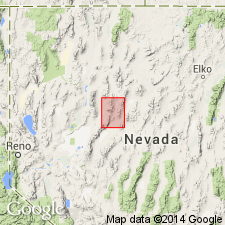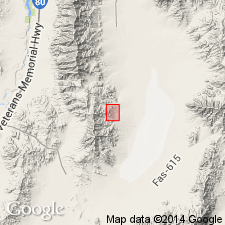
- Usage in publication:
-
- Favret formation
- Modifications:
-
- Original reference
- Dominant lithology:
-
- Limestone
- Shale
- AAPG geologic province:
-
- Great Basin province
Summary:
Favret formation. Thin-bedded black bituminous limestone and interbedded black shale, generally underlain by massive dark-gray to brown dolomite. Thickness at type locality 800 feet; locally much thinner. Conformably underlies Augusta formation (new); overlies Dixie Valley formation (new), contact gradational. Age is Middle Triassic.
Type locality: Favret Canyon, west slope of Augusta Mountain, north-central NV.
Source: US geologic names lexicon (USGS Bull. 1200, p. 1329).

- Usage in publication:
-
- Favret Formation
- Modifications:
-
- Revised
- AAPG geologic province:
-
- Great Basin province
Summary:
[The following synopsis is from Fossil Hill Member entry.] Fossil Hill Member or Formation of the Star Peak Group is adopted as defined by Nichols and Silberling (1977). Is the upper member of the Favret Formation in the southern Tobin Range and Augusta Mountain; middle member of the Prida Formation in the Humboldt and northern East Ranges; Fossil Hill Formation at China Mountain and in the southern Augusta Mountain. Is composed of fissile to flaggy, dark-gray, calcareous shale with concretionary fossiliferous lime-mudstone interbeds. Thickness is 200 m. Age is Middle Triassic (Anisian) based of fossils [cephalopods].
Source: GNU records (USGS DDS-6; Menlo GNULEX).
For more information, please contact Nancy Stamm, Geologic Names Committee Secretary.
Asterisk (*) indicates published by U.S. Geological Survey authors.
"No current usage" (†) implies that a name has been abandoned or has fallen into disuse. Former usage and, if known, replacement name given in parentheses ( ).
Slash (/) indicates name conflicts with nomenclatural guidelines (CSN, 1933; ACSN, 1961, 1970; NACSN, 1983, 2005, 2021). May be explained within brackets ([ ]).

